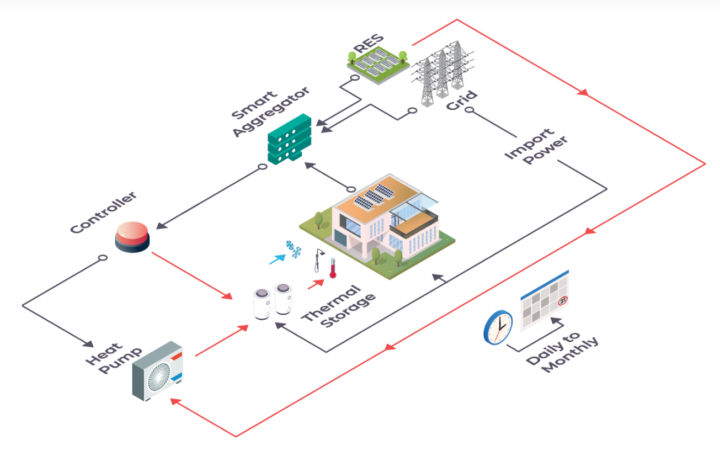Thermal Energy Storage as a Flexibility Asset in Sector Coupling – First Steps

According to Solar Power Europe, 2023 marks another record year for solar PV in the EU, with 55.9 GW installed across the 27 Member States, showing a 40% growth from 2022 and a doubling of the market in just two years. Wind Europe states that EU-27 installed 16.2 GW of new wind power in 2023, a record amount. These are among the many evidences that European power grids will need an increasing amount of flexibility on the demand side to ensure a proper balancing, given renewable energy sources (RES) are not predictable and renewable electricity should be used as it becomes available.
Storing electricity as such is expensive. According to the World Hydropower Outlook 2024, pumped storage covers more than 90% of stored electricity worldwide. Hence, additional storage technologies are required to diversify and increase the storage capacity.
One of the questions HYSTORE is trying to answer is whether thermal energy storage (TES) can actually contribute significantly to making the energy system more flexible. The simple answer is obviously positive, especially for large TES units, e.g. connected to district heating and cooling (DHC) and being heated via large heat pumps. Nevertheless, it has to be considered that the DHC potential is limited, considering that approximately 19,000 DHC grids are operating in Europe. Some interesting potential can be sought in the domestic-scale TES. If properly aggregated and well managed, that TES capacity could offer additional flexibility potential in a power-to-heat approach. HYSTORE is developing a Smart Aggregator for integrating TES in building energy systems and directly with grid services, that may serve for that purpose.
Quantifying the installed TES capacity at the domestic level in Europe is hard. Taking into consideration only the electric DHW tanks in EU28, a total storage capacity of about 125 GWhth was recently estimated by Luisa Cabeza, Harald Mehling, and Joaquim Romaní from Lleida University.
Furthermore, since renewable heating and cooling (RHC) technologies typically come with a TES (e.g. solar thermal, biomass boilers, heat pumps), one could imagine also exploiting that capacity to store RES electricity-generated heat. This is obvious with heat pumps, but could be extended to solar thermal and biomass boilers if, e.g., an electric resistance was added to the TES, or working in combination with a heat pump.
As a concrete example, looking at ENTSO-E publicly available data, the Italian CNR-ITAE calculated that RES electricity was in surplus for almost 1,900 h in 2023 in Austria. The maximum RES surplus in one day amounts to 4.2 GWh. The installed capacity of solar thermal-connected TES can be roughly estimated to 26 GWh (4.6 Mm2 of solar thermal panels installed according to IEA SHC).
This initial calculation is rough and needs to consider several constraints, such as the fact that not all the TES volume connected to a solar thermal system can be exploited for electric heating (otherwise the solar energy could not be stored), but it provides insight into the order of magnitude.
Using domestic TES to provide flexibility could allow for additional economic benefits (reduced electricity prices, direct incentives), thereby improving the economics of a TES system. Could this also impact the typical sizing rules of domestic TES? This will be investigated in the course of the HYSTORE project.
Marco Calderoni
R2M Solution – technical manager
Exploitation manager in HYSTORE